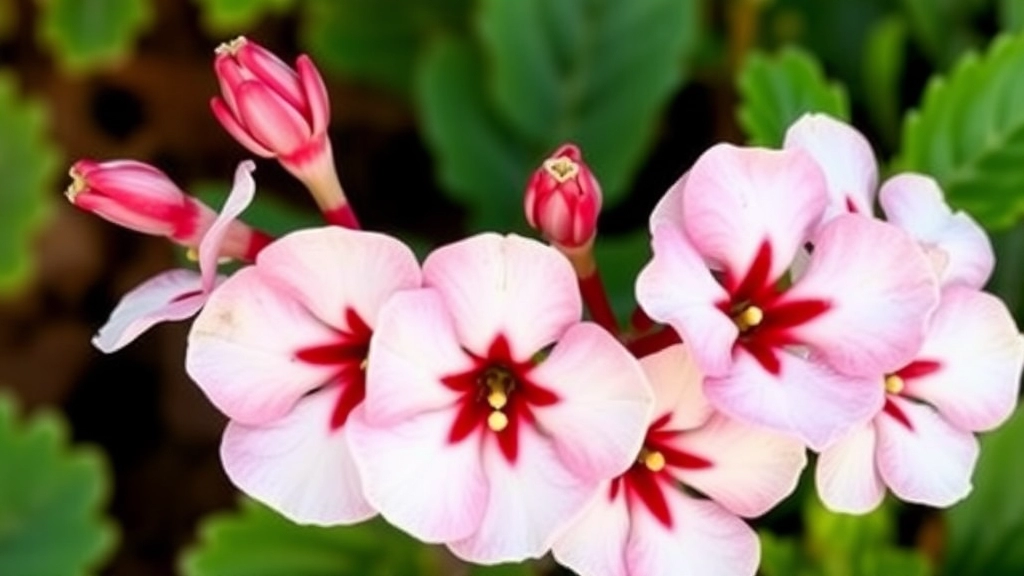Kalanchoe Calandiva White Care Guide
If you’re looking to add a touch of elegance to your indoor garden, the Kalanchoe Calandiva White is a stunning choice. This beautiful plant, known for its lush white blooms, is a favourite among houseplant enthusiasts for its low-maintenance needs and eye-catching appearance. In this guide, I’ll share essential care tips to help your Calandiva White thrive, from light requirements to proper watering techniques.
Understanding Your Plant’s Needs
Understanding the specific needs of your Kalanchoe Calandiva White is key to ensuring its health and longevity. Whether you’re curious about the ideal soil mix, the best indoor placement, or how to propagate new plants, I’ve got you covered. Let’s dive into the best practices for keeping your Calandiva White in top shape, so you can enjoy its beauty year-round.
Light Requirements for Calandiva White
When it comes to growing Kalanchoe Calandiva White, one of the most pressing concerns is ensuring your plant receives the right amount of light.
Why is Light So Important?
Calandiva White thrives in bright, indirect sunlight. Insufficient light can lead to leggy growth and fewer blooms, while too much direct sunlight can scorch the leaves.
Ideal Soil for Kalanchoe Calandiva White
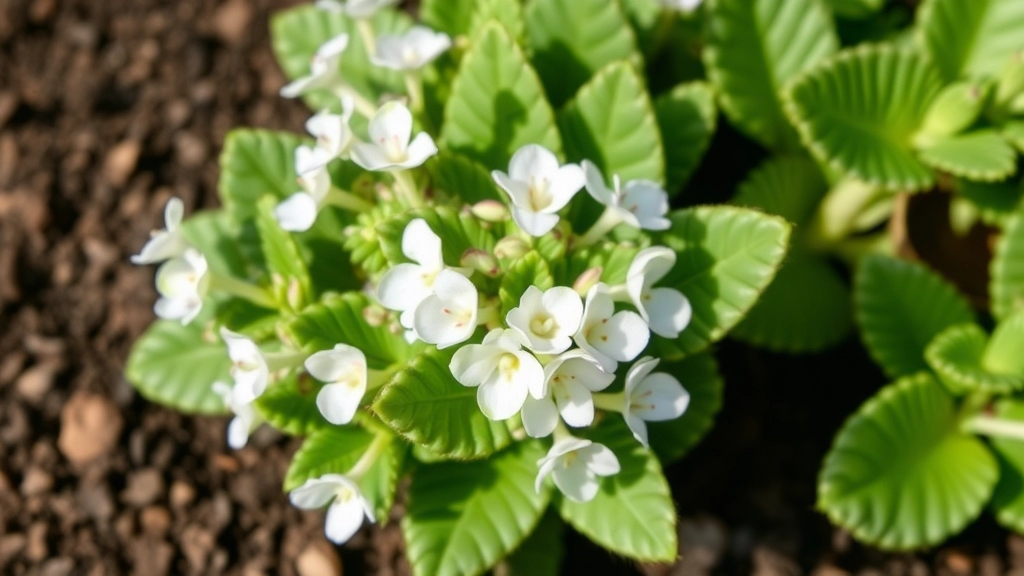
So, you’ve got your Kalanchoe Calandiva White, and now you’re wondering, “What’s the best soil for it?”
Well, let me tell you, the right soil mix is crucial for keeping your plant healthy and thriving.
Key Soil Characteristics:
- Well-Draining: This plant doesn’t like soggy roots. A mix that drains well will help prevent root rot.
- Lightweight: A lighter mix allows for good air circulation around the roots.
- Slightly Acidic to Neutral pH: Aim for a pH between 6.0 and 7.0. This helps the plant absorb nutrients better.
Recommended Soil Mix:
You can easily create your own mix at home. Here’s a simple recipe:
- 60% Potting Soil: This provides the essential nutrients.
- 20% Perlite: This improves drainage and aeration.
- 20% Sand: This also aids in drainage and gives the soil a bit of weight.
Store-Bought Options:
If DIY isn’t your thing, look for commercial cactus or succulent mixes. They’re designed to be well-draining and lightweight, perfect for your Calandiva.
Tips for Soil Maintenance:
- Repotting: If your plant starts looking a bit sad, it might be time to refresh the soil. Repot every couple of years.
- Check for Compaction: If the soil seems dense, it may need a refresh to improve drainage.
Proper Watering Techniques for Calandiva White
When it comes to keeping your Calandiva White thriving, watering is one of the most critical aspects to consider. Many plant enthusiasts worry about overwatering or underwatering, which can lead to serious issues.
Understanding Watering Needs
Calandiva White, like other Kalanchoe varieties, is a succulent that prefers dry conditions. Here are some key points to ensure effective watering:
- Soil Check: Always check the soil moisture before watering. Insert your finger about an inch into the soil; if it feels dry, it’s time to water.
- Watering Frequency: Typically, watering every two to three weeks is sufficient. However, this may vary based on your home’s humidity and temperature.
- Watering Method: Water thoroughly until you see excess water draining from the bottom. This ensures that the roots get enough moisture while preventing root rot.
- Seasonal Adjustments: During the growing season (spring and summer), you might need to water more frequently. In contrast, reduce watering in the dormant months (fall and winter).
Signs of Overwatering and Underwatering
Recognising the signs of improper watering can save your plant from distress:
- Overwatering Symptoms: Yellowing leaves, mushy stems, or a foul smell from the soil indicate excess moisture. For more insights, check out why Kalanchoe bottom leaves turn yellow.
- Underwatering Symptoms: Wrinkled leaves or a drooping appearance suggest your plant is thirsty. Learn more about why Kalanchoe plant leaves turn brown.
Temperature and Humidity Preferences

When caring for your Kalanchoe Calandiva White, understanding its temperature and humidity preferences is crucial for thriving growth. Have you ever wondered why your plant isn’t blooming as expected? Temperature and humidity could be the key factors.
Ideal Temperature Range
Kalanchoe Calandiva White thrives in a specific temperature range:
- Daytime: 20°C to 25°C (68°F to 77°F)
- Nighttime: 10°C to 15°C (50°F to 59°F)
Maintaining these temperatures encourages healthy growth and vibrant blooms.
Humidity Levels
Calandiva White prefers moderate humidity levels:
- Ideal Humidity: 40% to 60%
If the air is too dry, your plant may struggle. Consider using a humidity tray or misting the leaves occasionally to create a more suitable environment.
Seasonal Considerations
Be mindful of seasonal changes:
- Winter: Keep your plant away from cold drafts and heating vents.
- Summer: Ensure it’s not exposed to intense direct sunlight, which can elevate temperatures excessively.
By keeping these temperature and humidity preferences in check, you can significantly enhance your plant’s health and flowering potential.
Fertilizing Guidelines for Optimal Growth
As we dive deeper into caring for your Calandiva White, let’s talk about fertilizingâan essential aspect for promoting vibrant blooms and robust growth.
Why Fertilizing Matters
Many plant enthusiasts often wonder why their Kalanchoe Calandiva White isn’t thriving as expected. The answer frequently lies in the nutrients provided. Proper fertilization can make a significant difference in the health and appearance of your plant.
When to Fertilize
- Growing Season: Fertilize during the active growth period, typically from spring to early autumn.
- Frequency: Every 4-6 weeks is ideal during this time.
Types of Fertilizers
- Balanced Fertilizer: A balanced, water-soluble fertilizer (like 10-10-10) is perfect for Kalanchoe.
- Liquid Fertilizer: Opt for a diluted liquid fertilizer to avoid overwhelming the plant.
Application Tips
- Dilution: Always dilute the fertilizer to half the recommended strength to prevent root burn.
- Watering First: Water your plant before applying fertilizer to ensure the roots are hydrated and can absorb the nutrients effectively.
- Avoid Over-Fertilizing: Too much fertilizer can lead to salt build-up, which may harm your plant.
Signs of Nutrient Deficiency
- Pale Leaves: This may indicate a lack of nitrogen.
- Stunted Growth: Could point to insufficient nutrients overall.
For more detailed care tips, you might want to explore our complete guide on caring for Kalanchoe succulents. Additionally, understanding the taxonomy and classification of Kalanchoe Blossfeldiana can provide further insights into optimal care practices.
How to Propagate Calandiva White Successfully
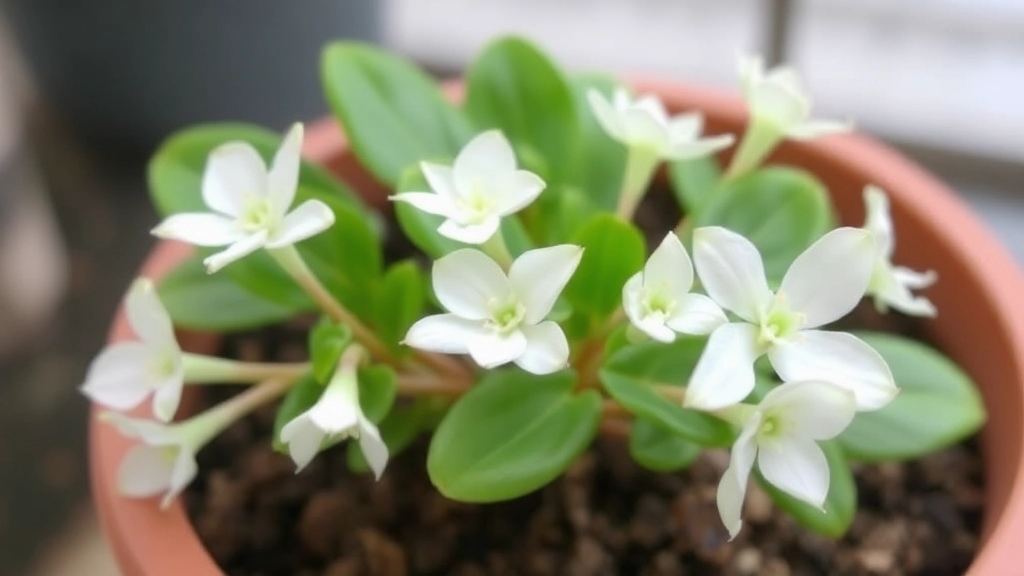
So, you’ve got a beautiful Calandiva White and you’re thinking, “How can I get more of these stunning plants?” Great idea! Propagating Kalanchoe Calandiva White is not only rewarding but also pretty straightforward.
Why Propagate?
Maybe you want to share the love with friends or fill your home with more blooms. Whatever your reason, let’s dive into how to do it without a hitch.
Steps to Propagate Calandiva White
- Choose the Right Stem
Look for a healthy stem with a few leaves. It should be about 4-6 inches long. Snip it off cleanly using sterilised scissors to avoid any infections. - Let It Callous
Place the cutting in a dry, warm spot for a few hours or even a day. This helps the cut end heal and reduces the risk of rot. - Prepare the Soil
Use a well-draining soil mix. A cactus or succulent mix works wonders. You can even add perlite for extra drainage. - Plant the Cutting
Stick the cutting into the soil, burying about an inch of the stem. Give it a gentle press to secure it in place. - Water Sparingly
After planting, mist the soil lightly. Avoid soaking it. Too much water can lead to root rot, which we want to dodge at all costs! - Provide the Right Environment
Place the pot in a warm area with bright, indirect light. Avoid direct sunlight, as it can scorch the cutting. - Wait and Watch
In a few weeks, you should see new growth. That’s your cue that roots are forming! - Transplant When Ready
Once your new plant has a few roots and is looking healthy, you can transplant it into a bigger pot.
Tips for Success
- Patience is Key: Not all cuttings will take. Don’t be discouraged if some don’t make it.
- Use Multiple Cuttings: If you’re eager for more plants, try taking several cuttings at once.
- Keep an Eye on Moisture: Always check the soil before watering. It should be dry to the touch.
Common Pests and How to Treat Them
As we delve into the care of your Calandiva White, it’s essential to address a pressing concern: pests. Many plant lovers often worry about the potential threats to their beloved Kalanchoe.
Identifying Common Pests
The most frequent pests that can affect Calandiva White include:
- Aphids: Small, soft-bodied insects that cluster on new growth.
- Mealybugs: White, cotton-like masses found in leaf axils and on stems.
- Spider Mites: Tiny, spider-like creatures that create fine webbing.
- Scale Insects: Small, brownish bumps on stems and leaves.
Treatment Options
Here’s how to effectively deal with these pests:
- Aphids:
- Spray with a strong jet of water to dislodge them.
- Use insecticidal soap or neem oil for severe infestations.
- Mealybugs:
- Dab them with a cotton swab dipped in rubbing alcohol.
- Introduce natural predators like ladybugs.
- Spider Mites:
- Increase humidity around the plant.
- Apply miticides or insecticidal soap to affected areas.
- Scale Insects:
- Manually remove them with a soft brush or cloth.
- Use horticultural oil to suffocate them.
Prevention Tips
To keep your Calandiva White thriving and pest-free, consider these preventive measures:
- Regular Inspection: Check your plants weekly for any signs of pests.
- Healthy Environment: Maintain optimal light, temperature, and humidity levels.
- Proper Airflow: Ensure good air circulation around your plant.
For more detailed care, you might find our Calandiva Kalanchoe Plant Care Guide useful. Additionally, if you have other Kalanchoe varieties, check out our Top Succulent Kalanchoe Types and Care Tips for more information.
How to Prune Calandiva White for Re-Blooming
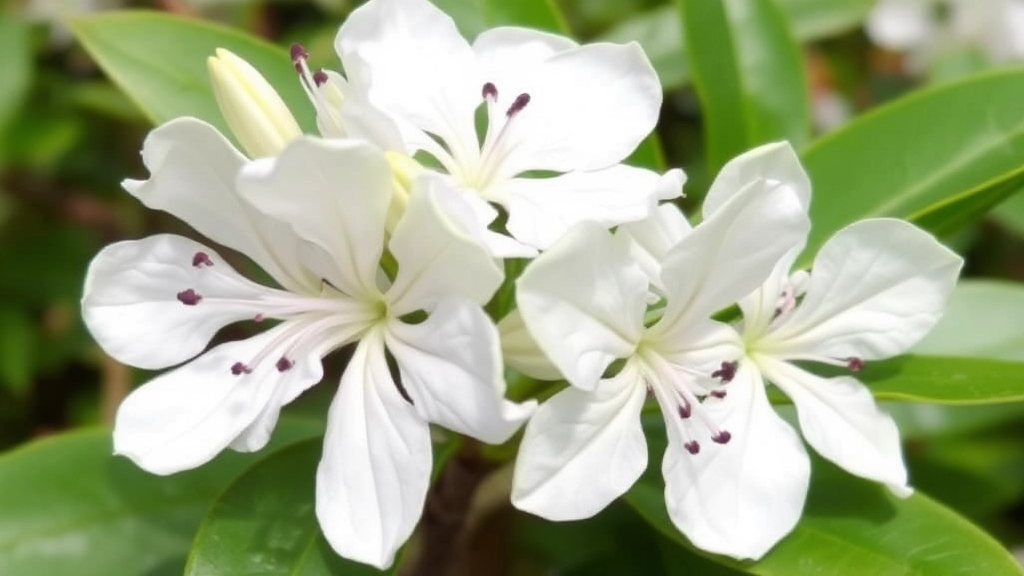
So, you’ve got your Calandiva White looking all lovely, but now you’re wondering how to get it to bloom again? Pruning is your secret weapon!
Why Prune?
Pruning helps your plant focus its energy on new growth and blooms. It’s like giving your Calandiva a fresh start!
When to Prune
- Post-Bloom: Wait until the flowers have faded.
- Spring: Ideal time for a trim as the plant wakes up.
Steps to Prune Calandiva White
- Gather Your Tools: You’ll need sharp, clean scissors or pruning shears.
- Inspect the Plant: Look for dead or yellowing leaves and spent flowers.
- Cut Back: Trim the stems down to just above the first set of healthy leaves. This encourages new growth.
- Remove Dead Leaves: Snip away any leaves that look tired or unhealthy.
- Shape It Up: Aim for an even shape to promote balanced growth.
Aftercare
- Watering: Give it a little drink after pruning, but don’t overdo it.
- Light: Ensure it gets plenty of bright, indirect sunlight to encourage new blooms.
Quick Tips
- Don’t Over-Prune: Less is more; you want to keep enough foliage for photosynthesis.
- Be Gentle: Treat your plant with care; it’s not a bush!
Best Indoor Placement for Maximum Bloom
When it comes to ensuring your Calandiva White thrives indoors, placement is crucial. You may wonder, “Where should I position my plant for the best blooms?”
Optimal Light Exposure
Calandiva White requires bright, indirect sunlight to flourish. Here are some tips for ideal placement:
- Near Windows: Position your plant near east or south-facing windows. This allows it to soak up morning or midday sunlight without the harsh afternoon rays.
- Avoid Direct Sunlight: Too much direct sunlight can scorch the leaves. If your window is particularly sunny, consider using sheer curtains to diffuse the light.
- Rotate Regularly: To ensure even growth, rotate your plant every few weeks. This helps all sides receive equal light exposure.
Humidity and Air Circulation
While Calandiva White is fairly adaptable, it does prefer a certain level of humidity:
- Avoid Stuffy Areas: Place your plant in a well-ventilated area. Avoid corners where air circulation is limited.
- Use a Humidifier: If your home is particularly dry, consider using a humidifier nearby, especially during winter months.
Temperature Considerations
Calandiva White thrives in temperatures between 18°C to 24°C. Keep these points in mind:
Managing Root Rot and Other Common Issues
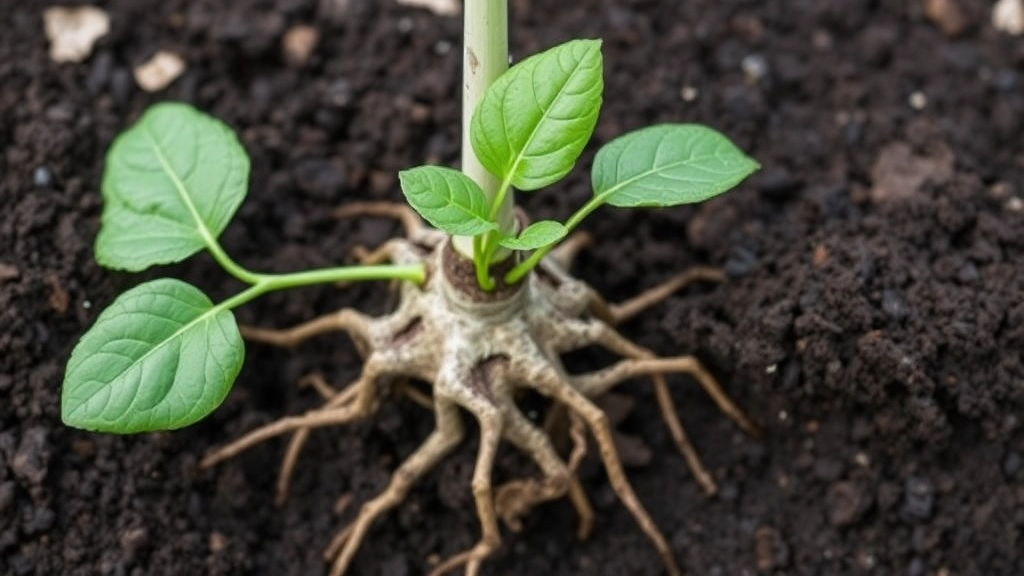
So, you’ve got your Calandiva White thriving, but suddenly, you notice something’s off.
Root rot is a sneaky issue that can catch you off guard.
It’s like that friend who shows up uninvited and wreaks havoc on your plans.
What is Root Rot?
Root rot is caused by overwatering or poor drainage, leading to soggy soil that suffocates the roots.
Here’s how to spot it:
- Yellowing leaves: If your leaves are turning yellow and dropping off, it’s a red flag.
- Mushy stems: A soft, mushy texture at the base is a sign of trouble.
- Foul smell: If it smells like a swamp, your plant is definitely not happy.
How to Manage Root Rot
- Check the Soil: Stick your finger in the soil. If it’s wet several inches down, hold off on watering.
- Repot: If you suspect root rot, gently remove the plant from its pot. Trim away any black, mushy roots.
- Use Fresh Soil: Repot in fresh, well-draining soil. A cactus mix works wonders!
- Water Sparingly: After repotting, water lightly. Let the soil dry out completely before the next watering.
Other Common Issues
Aside from root rot, keep an eye out for:
- Pests: Aphids and mealybugs love to munch on your Calandiva. A gentle spray of neem oil can help.
- Leaf Drop: This can happen if your plant is stressed. Check for temperature changes or drafts.
- Fading Flowers: If blooms are wilting, it might be a light issue. Ensure it’s getting enough bright, indirect sunlight.
Flowering Cycle and Bud Development in Calandiva White
Are you wondering when your Calandiva White will bloom, or why it might not be producing buds? Understanding the flowering cycle and bud development is crucial for ensuring your plant thrives and showcases its stunning white flowers.
Flowering Cycle Overview
The flowering cycle of Calandiva White typically begins in late winter to early spring. This is when the plant starts to prepare for its blooming phase. Here’s what you can expect:
- Initial Growth Phase: After a period of dormancy, the plant will show new growth. This is the time to ensure it has optimal light and water.
- Bud Formation: As the days lengthen and temperatures rise, you’ll notice tiny buds forming. This is a sign that your plant is gearing up for a spectacular display.
- Blooming Stage: The buds will eventually open into full blooms, usually lasting several weeks. Proper care during this stage is essential to prolong the flowering period.
Factors Influencing Bud Development
Several factors can influence the successful development of buds in your Calandiva White:
- Light Exposure: Ensure your plant receives bright, indirect sunlight. Too little light can hinder bud formation.
- Watering Practices: Over-watering or under-watering can stress the plant, affecting its ability to produce buds.
- Temperature: Maintaining a stable temperature between 18-24°C (65-75°F) encourages blooming.
- Humidity Levels: While Calandiva White prefers moderate humidity, excessively dry conditions can impede bud development.
Encouraging Healthy Buds
To encourage healthy bud development, consider these tips:
XII. Long-Term Care Tips for Healthy Growth
So, you’ve got your Kalanchoe Calandiva White thriving, but how do you keep it that way long-term?
Here are some straightforward tips for keeping your plant in top shape:
- Regular Check-Ups:
- Keep an eye on your plant weekly.
- Look for signs of stress like yellowing leaves or wilting.
- Consistent Watering:
- Water when the top inch of soil feels dry.
- Avoid letting it sit in water to prevent root rot. For more details, check out our Kalanchoe Donkey Ear Plant Care Guide.
- Light Management:
- Rotate your plant every few weeks for even growth.
- If it’s stretching towards the light, it might need a brighter spot. Learn more in our Why Your Florist Kalanchoe Is Not Flowering: Solutions and Tips.
- Temperature Control:
- Keep it in a warm room, ideally between 18-24°C.
- Avoid cold drafts and sudden temperature changes.
- Humidity Awareness:
- Kalanchoe prefers lower humidity.
- If your home is too humid, consider using a dehumidifier.
- Fertilisation Routine:
- Feed your plant every month during the growing season.
- Use a balanced, water-soluble fertiliser diluted to half strength.
- Pest Patrol:
- Check regularly for pests like aphids or mealybugs.
- Use insecticidal soap or neem oil if you spot any.
- Pruning for Health:
- Remove dead or wilted flowers to encourage new growth.
- Trim back any leggy stems to promote bushiness.
FAQs for Kalanchoe Calandiva White
What is the best soil for Kalanchoe Calandiva White?
The ideal soil for Kalanchoe Calandiva White should be well-draining, lightweight, and have a slightly acidic to neutral pH (6.0 to 7.0). A recommended mix includes 60% potting soil, 20% perlite, and 20% sand.
Can I use store-bought soil for my Calandiva White?
Yes, commercial cactus or succulent mixes are suitable as they are designed to be well-draining and lightweight, perfect for Kalanchoe Calandiva White.
What are the ideal temperature and humidity levels for Calandiva White?
The plant thrives in daytime temperatures of 20°C to 25°C (68°F to 77°F) and nighttime temperatures of 10°C to 15°C (50°F to 59°F). Ideal humidity levels range from 40% to 60%.
How do I propagate Kalanchoe Calandiva White?
To propagate, choose a healthy stem, let it callous, prepare a well-draining soil mix, plant the cutting, water sparingly, and provide a warm environment with bright, indirect light. New growth should appear in a few weeks.
When and why should I prune my Calandiva White?
Prune your plant post-bloom or in spring to encourage new growth and blooms. Pruning helps the plant focus its energy on healthy growth.
How do I manage root rot in my Calandiva White?
To manage root rot, check the soil moisture, repot the plant in fresh, well-draining soil, and water sparingly. Trim away any black, mushy roots before repotting.
What are common issues with Calandiva White and how do I address them?
Common issues include pests like aphids and mealybugs, leaf drop due to stress, and fading flowers from insufficient light. Use neem oil for pests, check for temperature changes for leaf drop, and ensure the plant gets enough bright, indirect sunlight for vibrant blooms.
References
-
Gardening Know How – Kalanchoe Calandiva Care
-
The Spruce – How to Grow Kalanchoe Calandiva
-
Houseplant411 – Kalanchoe Calandiva: How to Grow and Care Tips
